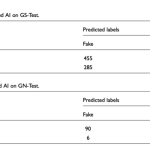
Australia’s Right Tried to Copy Trump. It’s Been a Disaster.
April 16, 2025
“Fake news detection” AI is more likely to fail in the Global South, new study shows
April 16, 2025Newsrooms in Colorado that once employed hundreds could now “fit around a large dinner table,” Larry Ryckman, publisher and co-founder of The Colorado Sun, told me in December.
Leaders at newsrooms like the Sun, seeing the rapid collapse of local news around them, are thinking about how they can do more to compensate for what’s being lost in their own backyards. One model they are betting on: Regional hubs. The Colorado Sun plans to establish four of them to serve communities in specific parts of the state.
“Regional hubs” might sound like the recreation of the regional bureaus for-profit local newspapers like The Denver Post and the Rocky Mountain News had in their heyday. But Ryckman makes a distinction. While bureaus were “writing for the mothership” more than serving individual communities, he says, the Sun’s hubs will be built from the ground up to serve and report on the smaller, region-specific communities they’re created for.
“We don’t intend to be arrogant and say, ‘We’re here from the Colorado Sun, and here’s how it’s going to be,’” Ryckman said. “The real work begins with a lot of listening.”
Not all use the language “regional hubs.” But a growing number of nonprofit newsrooms and local public radio stations, supported by big investments, are pursuing some kind of network model as one of the best hopes of sustainability for delivering more local news to more communities.
The American Journalism Project, the venture philanthropy that has raised more than $200 million for local news since 2019, is investing in and fundraising on this vision for scaling local news. Last fall, it awarded $3.6 million in grants to three nonprofit newsrooms to help them “expand their reporting to reach audiences lacking access to quality local news.” The Colorado Sun was one of the newsrooms to receive such funding.
About a month earlier, The Texas Tribune had announced that it would launch “a network of local newsrooms that will inform, empower and engage Texans at the community level” with $2.75 million in AJP backing; it named the founding team of the first newsroom in that network, The Waco Bridge, in February.
And when the Houston Landing, a nonprofit that raised $20 million pre-launch from supporters including AJP, announced Tuesday it would cease publication next month, it also said the Landing’s board “has entered into discussions with The Texas Tribune, which is exploring the possibility of establishing a Houston news initiative” as part of its local journalism initiative. (Texas Tribune editor-in-chief Matthew Watkins said those discussions are “in the early stages.”)
AJP labels this approach a “multi-local” or “network” model, CEO Sarabeth Berman told me. The idea is to consolidate business and operational infrastructure as a backbone that can support local reporting in multiple communities — especially smaller communities that might not be able to sustain standalone local news operations. (Three-quarters of news deserts are in rural areas.)
NPR, meanwhile, has been linking its existing stations into regional newsrooms since 2019, supported by investments from the Corporation for Public Broadcasting and philanthropy. (NPR members of regional newsrooms specifically warn that a loss of federal funding would put these regional collaborations at risk.) These regional newsrooms share positions and resources to fuel investigative reporting and breaking news alike. Where the nonprofit newsrooms are using their regional or statewide structure to build up operations in local communities, NPR stations are in some ways doing the reverse: building central resources that can bolster existing local stations across a region. The thinking behind both models, though, is similar: make fewer resources go further to fill local reporting gaps.
The model could allow local reporters to be part of bigger, better-resourced teams, while maintaining a level of community trust that’s out of reach for most national counterparts. (Leaders at multiple newsrooms pointed admiringly to Cityside — born in Berkeley in 2009 as part of the first wave of nonprofit local newsrooms, then expanded with the launch of The Oaklandside in 2020, and Richmondside last year — as a role model for how to sustainably deliver local news to multiple communities. Cityside’s revenue streams include foundations, major donors, memberships, and advertising and sponsorships; it, too, is an AJP grantee.)
Ryckman sees philanthropy as necessary seed funding for the regional hubs, but realizes grants won’t cut it for long-term sustainability. “Local revenue streams are the key to making the regional hubs sustainable,” he said, even as grants help provide the “runway to launch.”
No “Bigfooting”
Sonal Shah, outgoing CEO of The Texas Tribune, stressed that The Waco Bridge is for the community of Waco.
“It’s not statewide coverage for local communities. It’s local community coverage for local communities,” she said. “Trust is going to be built bottom up.”
The Waco Bridge’s independent name and branding reflect that local-first focus. (Recent research indicates that putting a local community’s name in the news outlet name increases trust in that news source.) “It wasn’t The Texas Tribune coming in and reporting in Waco,” Shah said. It’s, rather, “Waco reporting in Waco,” benefiting from the Texas Tribune’s experience and business infrastructure.
After the Lee Enterprises–owned Waco Herald-Tribune cut back on its coverage and consolidated some positions with other papers, the Waco Community Foundation reached out to the American Journalism Project to commission a study about the state of local news in the community. Following that research, AJP reached out to the Tribune. That outreach served as a spark for the Tribune: “If we can do it in Waco, we should do it in other parts of the state,” Shah said.
Later this year, the Tribune plans to launch its second local newsroom in Austin, where its statewide operation is already headquartered and its brand is trusted.
The Tribune is in the process of hiring reporters for The Waco Bridge. The possibility of the Tribune establishing a Houston news initiative following the shutdown of the Landing “does not impact our plans for Waco or Austin,” Watkins said. The Tribune will “explore the idea of Houston in the coming months.”
“It’s too early to say what a Tribune local news presence there would look like,” Watkins added. “Houston already has some strong news outlets, including the Chronicle, so we’d need to ensure that anything we did would be additive. We’d need to be confident that it would be financially sustainable and fit the mission of the Tribune.”
Shah and Berman both see community buy-in as a critical ingredient of success for local newsrooms linked to bigger, regional operations. “We don’t want to come in and try to Bigfoot everybody,” Shah said.
Other ingredients AJP thinks are essential for this model to succeed, according to Berman: Understanding the local community and its preexisting media ecosystem (to the extent that there is one); cultivating local stewardship, including leaders who might serve as board members or funders; and establishing a “shared sense of ownership” where the community sees, and supports, collaboration with a larger network as the path to sustainability for their local news outlet. She views leadership as “the biggest differentiator between organizations that are performing incredibly well and organizations that aren’t.”
In a follow-up email, I asked if Berman if AJP had any specific “lessons learned” from the closure of The Wichita Beacon last year. The Beacon’s Wichita newsroom, launched with AJP support in 2021, was the second newsroom launched by The Beacon after its Kansas City newsroom. “The lessons I shared were informed by our experience investing in and working with several grantees, including The Beacon,” Berman said.
“It’s almost an imperative to build a network in this way”
Deep South Today, another AJP grantee, began with Mississippi Today in 2016, then expanded to Louisiana with the launch of Verite News in 2022. Warwick Sabin joined as CEO in 2023.
“Our approach is to make sure that both newsrooms are local” in terms of editorial coverage, brand identity, and how audiences relate to their content, Sabin said. Meanwhile, core business functions like finance, people and culture, HR, and legal are centralized.
Deep South Today operates in one of the poorest regions of the country. “In our region…it’s almost an imperative to build a network in this way,” Sabin said. While Deep South Today’s scale is comparable to organizations operating in mid-sized and large metros, that’s only possible for it because it covers multiple states. If you combine the populations of Mississippi (3 million), Louisiana (4.5 million), and Arkansas (where Sabin previously served as a state representative — also 3 million), only combined do those “start to approach the size of a mid-metro or large metro in the United States,” he noted. (Over 85% of digital only news sites in the U.S. are in metro areas.)
Growing too fast is risky, but growth and scale can make an operation like Deep South Today more sustainable, Sabin said. “The per-unit cost of doing journalism decreases” when business infrastructure is centralized and “we’re able to bring along the revenue support from new geographies,” he explained, and that’s true for both philanthropy and earned revenue opportunities.
Verite News and Mississippi Today are local first. But Sabin also believes regional desks can allow Deep South Today to expand its journalism and better serve its mission of providing quality journalism to all of its audiences. “Whether it comes to education, health, climate/environment, criminal justice — the states of Louisiana and Mississippi are wrestling with a lot of the same issues,” he said.
This month, Deep South Today announced a partnership with KFF Health News that brings a new health journalist to Verite. Through the partnership, both Verite and Mississippi Today will collaborate with KFF’s Southern Bureau to better inform and serve both regional and national audiences. The new partnership, Sabin said in the announcement, “will greatly enhance our efforts to provide critical information about health issues to the communities we serve in Louisiana and Mississippi.”
For NPR’s regional newsrooms, a focus on sharing resources that can “lift all boats”
Before NPR’s California Newsroom formally took shape in 2020, several of the Golden State’s news outlets had the opportunity to collaborate thanks to a regional journalism grant from the Corporation for Public Broadcasting. Ethan Toven-Lindsey, VP of news at KQED, described the partners as having “built a lot of the muscles” to trust one another editorially and financially by working together on that grant, laying the foundation for the regional newsroom. Key to that trust: Ensuring that no one newsroom gets more financial benefit than others from the collaborative, and thinking about which resources “lift all boats” and are worth investing in regionally.
With its early funding, the regional newsroom hired a managing editor, an investigative editor, and a data journalist. The managing editor position is now operationalized — NPR, CalMatters, and other California newsroom partners pay for it and no longer rely on grant funding.
They’ve learned that breaking news and investigative reporting are two areas where collaboration and shared resources can help everyone. “We didn’t know [the regional newsroom] was going to have an investigative focus,” Toven-Lindsey said. “But investigative reporting became one of the things that benefited the widest spread of stations [and partners] — both big and small stations [and partners].”
The regional newsroom has used that investigative capacity to report statewide projects, but it’s especially geared toward bolstering partners’ work on more local stories, Toven-Lindsey said. He pointed to one partner, KVPR, reporting on a scandal involving the Fresno police chief and working closely with top editors from the regional newsroom. “The reason those editors were working with Valley Public Radio was not [that this was] a statewide story,” he explained. “It was that KVPR is a member of this hub and needs help on this story — devote those resources to make sure that they produce great journalism.”
The California Newsroom’s latest investment in a central resource for member newsrooms is hiring audio and digital trainer/editors. “All outlets, from the larger to the smaller, have the same needs in terms of training and coaching and editing,” Toven-Lindsey said, because many of them hire reporters with strong print backgrounds who need support with other mediums. These two jobs are “as much mentors and coaches as they are editors,” he said. “The point is for them to work with the station, work with the reporter, to produce great journalism, but to do it in such a way that the next time, that station and that reporter needs them less.”
Toven-Lindsey’s “long-held dream” for the California newsroom, he said, is to build a system that allows reporters to remain local reporters while still providing a path for career advancement — perhaps staying in one smaller community, yet still feeding their best work into bigger or higher-profile outlets, from KVCR, to LAist, to KQED, to the national NPR report on California. In that vision, “they don’t have to move to Washington, D.C., to be one of the most important journalists in the country,” he said.
Meanwhile, the New England News Collaborative’s centralized positions consist of a digital and multimedia producer/editor; a director; a visuals journalist; and a managing editor. These positions all support the 10 member newsrooms, NENC managing editor Cori Princell told me, but being connected into a network has benefits that are bigger than those few positions.
Before joining the NENC leadership, Princell was managing editor at NHPR. Coming from one of the smaller member stations, she noted that the collaborative could “make our newsroom feel bigger” and help them fill gaps with quality coverage — especially on slower news days, or when reporters were out, or on holidays. The collaborative expands “the size of your newsroom, but also the skills you have in your newsroom, and the number of people that you can go to for support and ideas,” she said. It can be useful for story sharing, resource sharing (including photography and videography) and coordinating on stories on topics like elections, climate, and immigration.
“We’re a big old diverse state, but we need to talk to each other”
The Sun’s four regional hubs will be built out in northeastern Colorado, southern Colorado, the Western Slope, and the Eastern Plains. None of those regions are monoliths, but the Sun settled on them because they are each defined by certain politics and challenges, especially related to water, Ryckman said.
“We’re a big old diverse state, but we need to talk to each other. We all rely on each other,” Ryckman said. “And frankly, our challenge as a statewide news organization is to make stories from those places relevant to others around Colorado.”
“I’m not saying every city council race or every Eagle Scout story is a statewide story. It’s not,” he added. “But, ideally, there are stories that are of interest in those regions that also speak to people elsewhere around the state — because maybe they get their food from there, maybe they get their water from there, maybe they ski there, maybe they go mountain biking there.”
“Build it and they will come” is not an option for the Sun; the hubs will be tailored to each region’s needs in medium, as well as coverage/content. “What works in eastern Colorado might not be the best model for southern Colorado,” Ryckman said.
How fast the Sun can build out these hubs depends on what other funding comes through, and how quickly. “We’re over the moon happy about getting an AJP grant,” Ryckman said, but the $1.4 million grant alone isn’t enough to create the hubs, and the organization is also using it to add business staff.
The Sun was just awarded “a substantial grant from a regional funder,” Ryckman told me last week, and continues to pursue other funding opportunities. If the Sun were to receive other significant grants from individuals or philanthropies, the organization could get multiple hubs up faster. The alternative is to build more slowly, with one hub’s growth laying the financial foundation for launching the next one. “If we are having to go the ‘Berkeleyside makes Oaklandside possible’ route, that’s going to take a bit longer,” he explained. (Investments from AJP and from the Google News Initiative helped Cityside launch its Oakland newsroom.)
Whether it lands other big grants or not, though, “we’re determined to do this,” Ryckman said. And he hopes that the first four hubs are just the beginning. “We need more journalism, not less,” he said. “There’s so much that goes uncovered across a big state like this.”
Adobe Stock
Great Job Sophie Culpepper & the Team @ Nieman Lab Source link for sharing this story.










